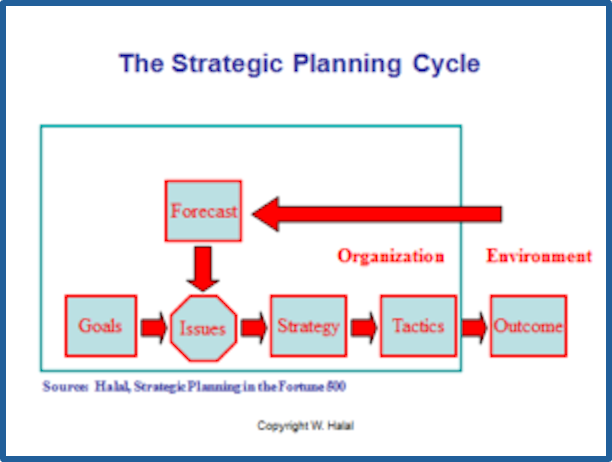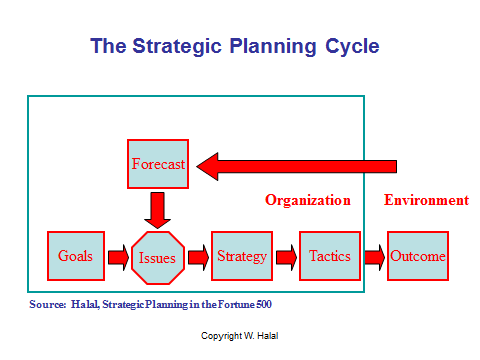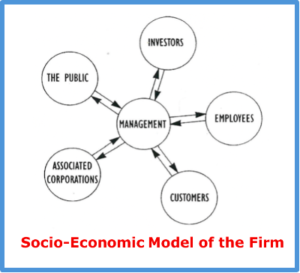Concerned about surviving today’s revolutionary changes?
This report provides an authoritative guide to the principles of strategic foresight. Using these key practices should give you and your organization confidence in planning for the future.
Strategic foresight is not limited to large corporations. Small business firms, government agencies, non-profits, and even individuals are being transformed by the technology revolution, globalization, and social trends. In principle, all planners and leaders today must plan for the ongoing wave of disruption or face disaster.
The generic strategic planning cycle below outlines the logic of strategic foresight. As shown, it begins by setting goals and defining an inspiring vision. Strategy can be best thought of as a “two-person game” (game theory) between the organization and the environment. The next step is to anticipate the future environment. The difference between where decision-makers hope to go (goals) and where the environment is leading (forecasts) then defines critical strategic issues. Strategic issues are the heart of good strategy because they pose the major obstacles to progress. After studying issues, it is important to pose a few alternative strategies, and to evaluate how well each is likely to perform in this environment to reach the goals. Decision makers are then able to select the most attractive strategy and implement it by defining tactics.

Yes, this requires lots of hard work, but it is crucial for a rapidly changing world. Netflix wiped out Blockbuster’s 6,000 retail stores by recognizing the competitive advantage of introducing streaming video. Toyota became the world’s largest car maker by anticipating the need for green transportation and developing the first hybrid autos. Apple dominates electronics because Steve Jobs bundled together major breakthroughs to create the iPhone.
Now, let’s get started by looking at the following strategic principles:
7 Principles of Strategic Foresight
1. Form a Cross-Disciplinary Team
The place to start is by organizing a small team of strategic thinkers from across your organization. To obtain diverse views, staff the Strategic Foresight Team with key personnel from all disciplines and units – operations, marketing, research, etc. Select persons with knowledge of foresight, strategic planning, environmental scanning and forecasting. Make sure they are curious and committed to change. The team should meet regularly and assign tasks to different members. They should also plan to keep the entire organization informed in order to promulgate strategic thinking throughout the system.
2. Define Your Vision and Goals
You cannot know where you are going without an inspiring vision. This requires hard abstract thought, and it may take several iterations to get it right, but please persist. Your vision should define an aspirational concept of what you hope to accomplish ideally and what it would look like when completed. The goals, in turn, define measurable outcomes that collectively make up the vision.
3. Forecast the Future Environment
To forecast effectively, allocate responsibility for scanning useful magazines, journals, websites, and other sources to specific individuals on the team. There are endless trends so focus on those that affect your organization and define the trends with a title and short description and examples. The team should review the results and select items of interest to be reported on.
4. Study Critical Issues
Do not confuse critical issues with forecasts as they are quite different. Forecasts tell you what is likely to happen, while Issues focus on the crucial problems facing your organization. A variety of forecasts may point to the same issue. Most organizations have several issues that resisted solution for years. People usually know what these problems are, but they are so difficult or poorly defined that they lay unresolved. But if you really want to energize your organization, bite the bullet and confront them head on.
5. Propose Alternative Strategies
Here is where creative thinking is needed rather than sheer objective efforts. Your most obvious strategy is to continue the present course of action, but please force yourselves to move beyond the status quo and think of bold new possibilities. Some may prove unworkable so narrow the options down to 2-5 major strategies.
6. Estimate Outcomes
The hard work begins now as you evaluate each alternative against the future trends the organization is facing, its power to cut through critical issues and the most likely outcomes in terms of achieving your goals. This is also a good opportunity to work together by pooling the estimates of team members and producing a consensus of your collective intelligence.
7. Select a Strategy to Implement
The final test of foresight is a creative strategy. Ideally the team should engage the organization’s decision-makers in thinking about which strategy would be best for the future environment you anticipate. Be sure to frame the task in concise terms and ask the organizations leaders to participate by providing estimates and comments. Again, use the power of collective intelligence. The resulting evaluation data is likely to be “owned” by the decision-makers, taken seriously, discussed for implications, revised, and acted upon.
Final Thoughts
Please note that this is a generic framework for strategy. Managers do this intuitively because it is basically problem solving. The process can take years, however, because managers usually cycle through these steps until all elements fall into place. And all organizations do this somewhat differently, so feel free to adopt your own modification of this approach.
If you have trouble with the process, TechCast is always available to help.
Good luck. The TechCast Team




